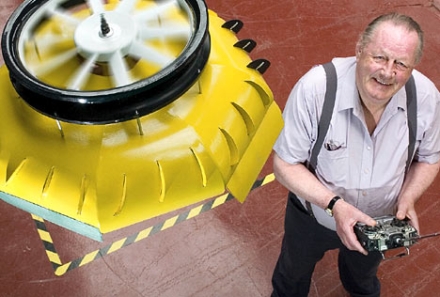Man's homemade flying saucer to be developed as surveillance droneThe Daily MailApr. 11, 2007 |
Popular 
Rep. Randy Fine: Pro-Palestine Movement Are 'Demons' Who 'Must Be Put Down by Any Means Necessary'

ADL Responds to DC Shooting With Call to Deplatform Twitch Streamer Hasan Piker

Israeli PM Netanyahu: Trump Told Me 'I Have Absolute Commitment to You'

Trump Confronts South African President on White Genocide

CNN: U.S. Officials Say Israel Preparing Possible Strike on Iran
 The age of the British amateur inventor toiling away in his humble garden shed lives on - and Geoff Hatton is proof of it. The former hovercraft engineer has designed and patented a flying saucer from his workshop in Peterborough that has grabbed the imagination of the American military establishment. Video: Now watch the amazing flying saucers in action  "My son said it was a bloody silly idea,' said Mr Hatton. "Now I've proved it works, he says sorry, he was wrong." The 68-year-old has won a contract with the US government for his 3ft-wide contraption, a cross between a hovercraft and a helicopter. It is being considered for surveillance sorties. "Unlike a helicopter, though, this is aerodynamically neutral and you can bump into walls and not smash the rotor,' said the inventor. "And, unlike a hovercraft, you can fly it as high as you want." The dome-shaped object is powered by an electricity-driven propeller on top that pushes air over the outer surfaces, and has controllable flaps. The device, which was rejected by the Ministry of Defence, was funded partly by a £43,000 development grant from the Department of Trade and Industry five years ago. The Americans are convinced that it has potential. "It's a unique approach which lends itself to a surveillance platform,' said Sal Gomez, of the US army's International Co-operative Programs centre. "It could be useful in urban areas because if it bumped into walls it could recover. This is just the earliest of days, like the Wright Brothers." Mr Hatton built his first model hovercraft for a church fete in 1964 and later helped build them in Britain and Canada. Divorced, he returned to England in 1979 and spent ten years as a market trader in Clacton. "I was always going on to people about how hovercraft could become flying saucers," he said. "They got fed up with it and said, "Get on and make one then!" So I did." He set about turning his workshops into his own mini-Area 51s - the secret US military testing sites in the Nevada desert. Mr Hatton won backing from friends, including business consultant David Evans. He said: "It's an idea that you look at and say to yourself, "Do you want to be like the first record producers who turned down The Beatles?"' Dr Holger Babinsky, an expert in aerodynamics at Cambridge University, also offered his expertise. Geoff's Flying Saucers - the original name for his GFS Projects company - are based on an aerodynamic principle that has been around for nearly 100 years. Known as the Coanda Effect, after a Romanian jet-engine pioneer, the principle is today used primarily in helicopters that have no tail rotors. Patents covering Mr Hatton's design were filed in March 2005 and the first controlled flights took place that year. Mr Evans said: "We can see a lot of prospects besides the military. Farmers in America already use unmanned aerial vehicles to inspect crops. Then there's search-and-rescue, aerial surveying and getting close to roofs." |



